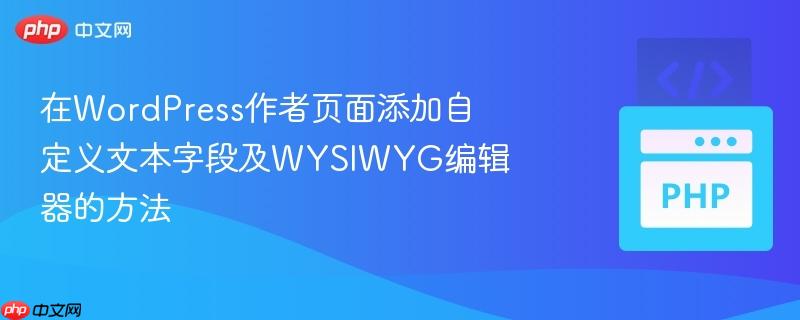
本教程详细介绍了如何在WordPress作者页面和用户资料中添加自定义文本字段,并支持WYSIWYG编辑器。文章提供了两种实现方案:通过`user_contactmethods`钩子进行代码定制,以及利用Advanced Custom Fields (ACF)插件实现无代码配置,帮助用户灵活扩展WordPress功能。
在WordPress中,有时我们需要在用户的个人资料页面(即后台的用户编辑页面)添加额外的信息字段,并将其展示在前端的作者页面上。这对于丰富用户简介、展示特定联系方式或个人描述等场景非常有用。本文将详细介绍两种实现此功能的方法:一种是使用WordPress的内置钩子进行代码定制,另一种是利用功能强大的Advanced Custom Fields (ACF)插件实现。
WordPress提供了一个名为user_contactmethods的过滤器钩子,允许开发者向用户的联系方式字段中添加自定义选项。这种方法适用于添加简单的文本字段,例如电话号码、城市或自定义描述等。
您可以通过将以下代码添加到当前主题的functions.php文件或自定义插件中,来扩展用户的联系方式字段。
<?php
if (!function_exists('my_custom_user_contact_methods')) {
/**
* 添加自定义联系方式字段到用户资料页
*
* @param array $profile_fields 现有联系方式字段数组
* @return array 修改后的联系方式字段数组
*/
function my_custom_user_contact_methods($profile_fields) {
// 添加新的字段
$profile_fields['custom_description'] = '自定义描述'; // 这是一个普通的文本字段
$profile_fields['user_phone_number'] = '联系电话';
$profile_fields['user_website_url'] = '个人网站';
return $profile_fields;
}
add_filter('user_contactmethods', 'my_custom_user_contact_methods');
}
?>代码解释:
添加此代码后,当您登录WordPress后台并编辑任一用户资料时,会在“联系信息”部分看到您添加的自定义字段,如“自定义描述”、“联系电话”等。
要在前端的作者页面(通常是author.php模板文件)显示这些自定义字段,您需要使用get_the_author_meta()函数来获取存储的值。
<?php
// 确保在作者页面模板文件 (如 author.php) 中使用
$author_id = get_query_var('author'); // 获取当前作者ID
// 获取自定义描述
$custom_description = get_the_author_meta('custom_description', $author_id);
if (!empty($custom_description)) {
echo '<div class="author-custom-description">';
echo '<h3>作者描述</h3>';
echo '<p>' . esc_html($custom_description) . '</p>'; // 使用 esc_html 进行安全输出
echo '</div>';
}
// 获取联系电话
$user_phone = get_the_author_meta('user_phone_number', $author_id);
if (!empty($user_phone)) {
echo '<div class="author-phone">';
echo '<span>电话: ' . esc_html($user_phone) . '</span>';
echo '</div>';
}
// 获取个人网站
$user_website = get_the_author_meta('user_website_url', $author_id);
if (!empty($user_website)) {
echo '<div class="author-website">';
echo '<span>网站: <a href="' . esc_url($user_website) . '" target="_blank">' . esc_html($user_website) . '</a></span>';
echo '</div>';
}
?>注意事项:
对于需要WYSIWYG编辑器或其他更复杂字段类型(如图片、文件、选择框等)的需求,使用Advanced Custom Fields (ACF) 插件是更高效、更灵活的选择。ACF提供了一个直观的用户界面来创建和管理自定义字段,无需编写任何PHP代码即可在后台配置。
安装并激活ACF后,您可以开始创建自定义字段:
现在,当您编辑任何用户资料时,会看到一个名为“作者附加信息”的新区域,其中包含您创建的自定义字段,包括带有WYSIWYG编辑器的“作者简介”。
要在前端的作者页面显示ACF字段,您需要使用ACF提供的the_field()或get_field()函数。
<?php
// 确保在作者页面模板文件 (如 author.php) 中使用
$author_id = get_query_var('author'); // 获取当前作者ID
// 使用 get_field() 获取字段值,并传递作者ID作为第二个参数
// 对于WYSIWYG字段,直接使用 the_field() 会输出格式化内容
if (function_exists('the_field')) { // 检查ACF是否激活
echo '<div class="author-wysiwyg-bio">';
echo '<h3>作者简介</h3>';
the_field('author_bio_wysiwyg', 'user_' . $author_id); // 'user_' . $author_id 是ACF获取用户字段的特定格式
echo '</div>';
}
// 获取其他文本字段,例如“座右铭”
if (function_exists('get_field')) {
$motto = get_field('author_motto_text', 'user_' . $author_id);
if (!empty($motto)) {
echo '<div class="author-motto">';
echo '<span>座右铭: ' . esc_html($motto) . '</span>';
echo '</div>';
}
}
?>代码解释:
选择建议:
无论选择哪种方法,都应确保在前端展示数据时进行适当的安全性处理,例如使用esc_html()或esc_url()等WordPress函数对输出内容进行转义,以防止跨站脚本攻击(XSS)。
以上就是在WordPress作者页面添加自定义文本字段及WYSIWYG编辑器的方法的详细内容,更多请关注php中文网其它相关文章!

每个人都需要一台速度更快、更稳定的 PC。随着时间的推移,垃圾文件、旧注册表数据和不必要的后台进程会占用资源并降低性能。幸运的是,许多工具可以让 Windows 保持平稳运行。

Copyright 2014-2025 https://www.php.cn/ All Rights Reserved | php.cn | 湘ICP备2023035733号